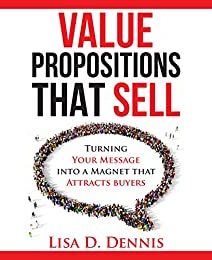It’s Primary time, when we all have to sift through lots of candidate pitches to figure out which one best addresses the themes and issues that we individually careabout. Yes – it’s all about messaging. Every candidate has a choice to make on how that message is crafted and what their value proposition should say. Many of them make an obvious choice – which is to make a negative pitch that denigrates their competitors to show, by default, that they are better. However, there are three different choices available to them to hone their pitch and increase their focus on the voters. It’s all about what type of value proposition they select as the framework for their message. It’s the same with your company’s offerings. Prospects are casting a vote when they decide to purchase. Your message has quite a bit to do with their decision process in making a selection. It’s a great time of year to ask yourself, as a candidate for my buyer’s attention, would my message get the vote?
Deciding How to Frame Your Message
Before you start to craft the words, it is really important to figure out what the best framework is to build your message on. Many of us don’t realize that there are actually three types of value propositions to choose from. In thinking about your voters, you need to consider what will best appeal to them – as opposed to which one YOU want to choose.
Type 1 – It’s all about ME
The focus here is all about your company or your offer. It is a very internal, me-centric approach that delivers all the features and benefits that your organization believes should be important. This type answers the question: Why would I vote for you? Seems like a good question, right? Maybe. Let’s take a look at the components you will need to craft this type:
- Complete product or service knowledge
- List of all the key features
- List of all the benefits
That seems fairly simple and direct, which is why it is the most often used type. However, there are some considerations here that may prove challenging when it comes to attracting your voters and getting them to take action. First, it is typically based on internal assumptions about what they value about your product or service. Secondly, there is often confusion about what the real difference is between a feature and a benefit. Check your messaging right now. If we can’t figure that out, trust me, your buyer won’t bother. If you do manage to get all your benefits nailed down, there is a strong possibility that not all of them have value to your buyers. A me-centric approach makes the assumption that at least some of them might stick. But this is definitely not a targeted approach. Overall this type of value proposition doesn’t typically require or use much customer insight – it’s all about the offer. Leaving the “voter” to figure out on their own how it relates to them.
Type 2 – It’s Me Versus Everyone Else
If you have been watching the 2016 Primaries, you will definitely recognize this type of value proposition. It complete focuses on the “opponents” by comparing and contrasting your offer with theirs. It is very much an “us versus them” type of approach. The opportunity to cast the opponents in a negative light is definitely irresistible – as our current slate of candidates are demonstrating every day.
But let’s take a look at how this value proposition can best be utilized and what the challenges might be. First, the question this type answers is slightly different: Why should I vote for you, instead of your competitors? Right off the bat, it recognizes that there are market alternatives to your own offer, which is a good thing to incorporate into your approach. It is much more externally focused than the first type.
The components you need for this type are:
- Complete product or service knowledge
- Details on your features and benefits
- Details on your competitors features and benefits
The first two are easy to gather, but getting at reliable, detailed competitor information isn’t always easy. You know who your competitors are. But what about “perceived alternatives?” These are additional choices that your voters think are an alternative to your offer, even though you don’t agree, or may not be aware of them. You might miss addressing these in your messaging.
Here’s one that often gets overlooked: not voting at all. If you skip building in a response to that one, you’ve got a nice hole in your value proposition. Finally, presenting your differentiators will be key in this type. The trick is figuring out which ones really matter to your voters. This type of value proposition still doesn’t deliver on good insight about your voters because it is typically hype-focused on your competition.
Type 3 – It’s all about the voter!
There is a better way – focusing on the voter and leading with their points-of view, needs, issues and desires. This seems like a no-brainer, but it is not the most frequent choice. Why? Because it is a lot more work, requires a lot more external information, and must shift the perspective from your company to their world.
The whole point to being a candidate in your market is to demonstrate how you can help them. So instead of telling your voters what you believe, consider this type of value proposition which delivers a message about their situation, goals, objectives, or challenges.
The question this type of value proposition answers really gets at the heart of what your message needs to address: What are the most important things I need to consider when making my decision? It acknowledges the voter’s decision making process, and seeks to help you net out the most relevant factors in your messaging.
It’s not about telling the voter everything you know. Instead, it’s about talking about only what matters to them – which will attract their attention. Since the other candidates are probably only talking about themselves, you can differentiate yourself automatically by only talking about what the voters care about. Here’s what you need for this type:
- Complete product or service knowledge
- Details on your features and benefits
- Details on your competitors features and benefits
- Defining the differentiating factors that matter
- Really understanding what the voters truly value
This takes more effort because you really need to know a lot about each of these components, and you need to integrate your understanding of them with voter insights and preferences. It also needs to be simple which means you have to net it out to just what matters to them – which isn’t everything you have to say! If you’re smart, you’ll also use their language to communicate it. Finally, no matter how many differentiators you have, you must focus on only the one or two that matter to your voter, and you need to be able to quantify and offer proof that it is real. Just saying that your offer is the best definitely will not cut it. Focusing on a single different feature that no one else has also won’t cut it if it’s not of significant value to your target.
Bringing the Message Home
Once you make your framework decision, you need to go do the homework so you have access to all the components you need. If you look at the current slate of candidates out there, how many of them would benefit from switching up their value proposition message to a voter-centric approach? Now ask yourself, what would be the best way to engage your voters when they are in the market looking for a solution?










